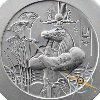
Sobek
CBUB Wins: 2
CBUB Losses: 3
CBUB Ties: 0
Win Percentage: 40.00%
Added by: SSJRuss
Read more about Sobek at: Wikipedia
Official Site: Public Domain
Sobek (also called Sebek), was an ancient Egyptian deity with a complex and fluid nature. He is associated with the Nile crocodile or the West African crocodile and is represented either in its form or as a human with a crocodile head. Sobek was also associated with pharaonic power, fertility, and military prowess, but served additionally as a protective deity with apotropaic qualities, invoked particularly for protection against the dangers presented by the Nile.
Sobek enjoyed a longstanding presence in the ancient Egyptian pantheon, from the Old Kingdom of Egypt (c. 2686–2181 BCE) through the Roman period (c. 30 BCE – 350 CE). He is first known from several different Pyramid Texts of the Old Kingdom, particularly from spell PT 317. The spell, which praises the pharaoh as the living incarnation of the crocodile god, reads:
The origin of his name, Sbk in Egyptian, is debated among scholars, but many believe that it is derived from a causative of the verb "to impregnate".
Though Sobek was worshipped in the Old Kingdom, he truly gained prominence in the Middle Kingdom (c. 2055–1650 BCE), most notably under the Twelfth Dynasty pharaoh, Amenemhat III. Amenemhat III had taken a particular interest in the Faiyum of Egypt, a region heavily associated with Sobek. Amenemhat and many of his dynastic contemporaries engaged in building projects to promote Sobek – projects that were often executed in the Faiyum. In this period, Sobek also underwent an important change: he was often fused with the falcon-headed god of divine kingship, Horus. This brought Sobek even closer with the kings of Egypt, thereby giving him a place of greater prominence in the Egyptian pantheon. The fusion added a finer level of complexity to the god's nature, as he was adopted into the divine triad of Horus and his two parents: Osiris and Isis.
Images with a green border may be set as the character's main profile image (For images 200x200 or 300x300 pixels square).
CBUB Match Record:
No Regular Play Records Available



